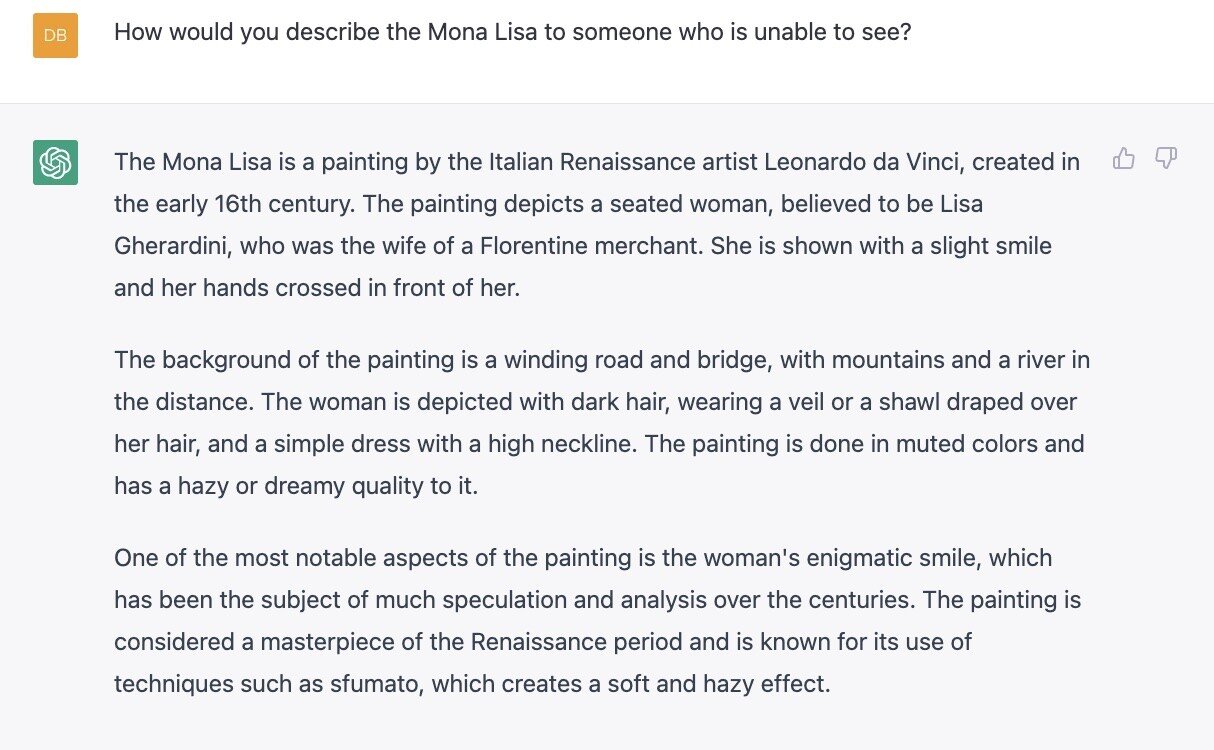Painting the Mona Lisa with Words
Adobe Firefly is one of the latest Generative-AI image creation and editing applications. One of the two tools released functions similarly to DALL-E or Midjourney, where users can input a prompt and receive a corresponding image. The other tool produces stylized text akin to WordArt but powered by AI.
The sample capabilities shown on the Firefly homepage are breathtaking (see examples below). Given Adobe's unique role at the center of the creative app ecosystem, the features they are building will redefine the future of video game design, graphic arts, and photography.
Example Capabilities of Firefly
ChatGPT Knows Art History
I received my early-access invite this morning and dove right in. Seeking inspiration for how to evaluate Firefly, I asked ChatGPT what the most famous paintings are. No surprise, the Mona Lisa came back in the first place.
But...being a text-only model, ChatGPT couldn't show me Da Vinci's famous painting, though it did kindly remind me that I could search Google or Bing to find it. Interestingly, ChatGPT was able to attempt to create an ASCII art version of the famed portrait, but the results were less than stellar.
ASCII Version of Mona Lisa (according to ChatGPT)
'Mona lisa' Prompt Didn't Produce the Best Results
I couldn't help but prompt Firefly with the most basic request one might use with a Google search, typing only 'Mona lisa' to see what result I'd get. I can't explain why an image of a potato and lemur were produced, but I wasn't surprised to see two of the four results throw errors, given the short prompt.
Luckily, ChatGPT is excellent with words, and it was able to provide a detailed description of the painting I could use for my Firefly text-to-image prompt.
Chat GPT wrote a fairly lengthy description of the painting, but I knew I'd need to extract the key descriptors to have any hope of a quality result. So while the history of the image is interesting, I focused on a few elements in its response:
seated woman
simply dressed
hands crossed in front of her
slight smile
winding road and bridge in background
Initial Results of Firefly's 'Mona Lisa'
The results that came back were surprisingly good (above). I've seen plenty of text-to-image queries fall flat, but Firefly had four unique representations that captured my request. Note the right sidebar of the Firefly application provides a set of image controls that allow you to adjust aspect ratio, styles, color, lighting, and more. This set of added controls built alongside the text prompts shows Adobe's prowess with UX. Half of the battle in generative is AI models, and the other half is augmenting the design process.
Four Unique Takes on a Reimagined Mona Lisa
I made a few additional adjustments to the prompt in the next test, adding "dreamy and hazy style" because entering "sfumato" resulted in an error when Firefly thought I was typing in another language (which is technically true). Finally, I took advantage of the style options adding 'Oil Painting' and 'Muted Color' to get as close as possible to Da Vinci's original style.
The final tweak to produce the images above was simply adjusting the aspect ratio, moving from square (1:1) to portrait (3:2) orientation. Keep in mind, this is still a 'beta' version, but the results show Adobe is poised to lead in this emerging category of technology.
“We’re not afraid of change, and we’re embracing this change,” -- Alexandru Costin
Back to Business
Generative AI Startup Valuations Are On The Rise
The business implications of generative AI continue to come into focus. Unsurprisingly, Venture Capitalist investments in generative AI have been steadily rising, as a recent PitchBook report indicates (TL;DR: up to $4.5B in 2022 from $408M in 2018).
The performance of models is increasing, and access to the models has opened up beyond the original gatekeepers to startups pushing the boundaries with new use cases across industries. We'll see deflationary pressure (reducing costs while increasing productivity) and shifts in the labor pool as AI augments more jobs. Finally, we'll see countless new jobs created like we did when the internet age came of age (e.g., social media managers, SEO specialists, app designers, etc.).
It's an exciting time to be alive with artificial intelligence doing things previously reserved for science fiction. But don't be satisfied watching and waiting -- run an experiment with a generative AI tool so you can disrupt a business process, 10x a customer experience, or even create your own masterpiece.









